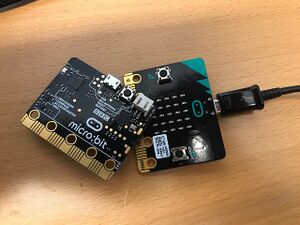Real-time sonification: Difference between revisions
David Sousa (talk | contribs) No edit summary |
David Sousa (talk | contribs) |
||
| Line 2: | Line 2: | ||
== Real-time sonification devices == | == Real-time sonification devices == | ||
[[File:Microbit.jpg|thumb|right|alt=View of the micro:bit on the both sides |The BBC micro:bit microcontroller]] | |||
To create a real-time sonification device it is useful to use a microcontroller. These are like "small and simple computers" with a single processor unit. They are not computers though. Their architecture is much simpler and they cannot run an operating system. Still, they can be programmed to execute a single program at a time, which can perform multiple tasks but sequentially, according to the order of the instructions listed in the program. | |||
There are several types of microcontrollers, the [https://www.arduino.cc/ Arduino (arduino.cc)] being the most popular. | |||
To begin with, the SoundScapes project suggests using the [https://microbit.org/ BBC micro:bit] microcontroller. This tool is very simple to use, versatile, and includes several embedded sensors readily available to use, eliminating the requirement to build a specific electrical circuit for operation. The micro:bit can be programmed online with [https://makecode.microbit.org/ Makecode] in python, javascript, or blocks. | |||
== Microbit == | == Microbit == | ||
Revision as of 17:55, 26 July 2024
Real-time sonification is an exciting technique that can strongly promote students' engagement in STEAM fields. Real-time sonification means that we are not able to perceive the time interval between the acquisition of the data and the respective sound produced by our sonification device because of the speed of the process. Moreover, the methods for creating sound representations of the data are defined simultaneously with data collection (in "real-time").
Real-time sonification devices

To create a real-time sonification device it is useful to use a microcontroller. These are like "small and simple computers" with a single processor unit. They are not computers though. Their architecture is much simpler and they cannot run an operating system. Still, they can be programmed to execute a single program at a time, which can perform multiple tasks but sequentially, according to the order of the instructions listed in the program. There are several types of microcontrollers, the Arduino (arduino.cc) being the most popular.
To begin with, the SoundScapes project suggests using the BBC micro:bit microcontroller. This tool is very simple to use, versatile, and includes several embedded sensors readily available to use, eliminating the requirement to build a specific electrical circuit for operation. The micro:bit can be programmed online with Makecode in python, javascript, or blocks.